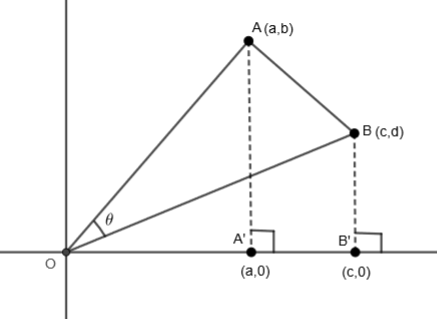Question
Question: If the line segment joining the points A (a, b) and B (c, d) subtends an angle \[\theta \] at the or...
If the line segment joining the points A (a, b) and B (c, d) subtends an angle θ at the origin, then cosθ is equal to:
(a) (a2+b2)(c2+d2)ac−bc
(b) (a2+b2)(c2+d2)ac+bd
(c) (a2+b2)(c2+d2)ac+cd
(d) None of these
Solution
Hint: In this question, we will first visualize the given situation and then we will try to apply the trigonometric formula, that is cos(α−β)=cosαcosβ+sinαsinβ. Also, we should know that cosα=hypotenusebase and sinα=hypotenuseperpendicular.
Complete step-by-step answer:
In this question, we have to find the value of cosθ where θ is the angle subtended by the line joining A (a, b) and B (c, d) at the origin. Here, we can represent the given situation as,

We have been given that the coordinates of A and B are (a, b) and (c, d) respectively. So, we can write the coordinates of A’ and B’ as (a, 0) and (c, 0) on the x and y axis. Let us consider ∠AOA′ as α and ∠BOB′ as β. So, we can write,
θ=α−β....(i)
So, from the figure, we can say that
cosα=OAOA′
cosβ=OBOB′
By using the distance formula, that is (x2−x1)2+(y2−y1)2, we will find the value of OA’, OA, OB’ and OB. So, we get,
OA′=(a−0)2+(0−0)2=a
OB′=(c−0)2+(0−0)2=c
OA=(a−0)2+(b−0)2=a2+b2
OB=(c−0)2+(d−0)2=c2+d2
AA′=(a−a)2+(b−0)2=b
BB′=(c−c)2+(d−0)2=d
So, we get,
cosα=a2+b2a
cosβ=c2+d2c
And, we know that
sinα=OAAA′ and sinβ=OBBB′
sinα=a2+b2b and sinβ=a2+b2d
And we know that θ=α−β. So, we will take cosine ratios to both sides.
cosθ=cos(α−β)
Now, we know that,
cos(α−β)=cosαcosβ+sinαsinβ
So, we get,
cosθ=cosαcosβ+sinαsinβ
Now, we will put the values of cosα, cosβ, sinα and sinβ in the above equation. So, we will get,
cosθ=a2+b2a×c2+d2c+a2+b2b×c2+d2d
cosθ=a2+b2c2+d2ac+bd
Hence, option (b) is the right answer.
Note: In this question, it is necessary to visualize the condition by drawing the figure because visualization from the virtual figure won’t help. Also, we may make a mistake at the point where we found that θ=α−β. Also, considering the correct angles will only give the correct answer.
